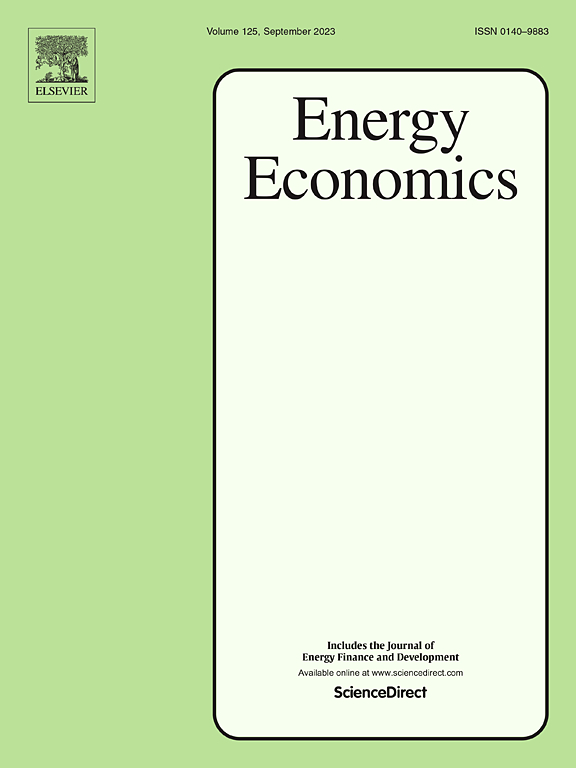The forward market dilemma in energy-only electricity markets
IF 13.6
2区 经济学
Q1 ECONOMICS
引用次数: 0
Abstract
Spot prices in energy-only markets, particularly those with high market price caps, are inherently volatile. As a result, forward markets for hedge contracts are a crucial design feature which guides systemic stability and allows the adequate operation of competitive wholesale and retail markets. Hedge contracts have historically been sold by large base, intermediate and peaking generators to risk-neutral and risk-averse energy retailers. However, as the electricity sector decarbonises and intermittent renewable market share rises, baseload plant exit is predictable, and along with them, so does their hedge contract capacity. Many governments are seeking to accelerate the entry of renewable projects through government-initiated two-way fixed price Contracts-for-Differences (CfDs), typically by way of auction. Because government is the counterparty, CfDs are ‘off-market’ and unless carefully designed, can produce a structural shortage of primary issuance hedge contract capacity. We model the forward markets in Australia's National Electricity Market and find structural shortages may materialise if off-market fixed price methods dominate because the CfD forms the ‘primary hedge’ for renewable entrants – and output cannot be prudently hedged twice. Conversely, when on-market PPAs dominate, or government CfDs are structured to be compatible with active forward market participation by renewable entrants, shortages can be eliminated.纯能源电力市场的远期市场困境
纯能源市场的现货价格,尤其是那些市场价格上限很高的市场,本质上是不稳定的。因此,对冲合约的远期市场是一个至关重要的设计特征,它指导系统稳定,并允许竞争性批发和零售市场的充分运作。从历史上看,对冲合约是由大型基础、中间和峰值发电企业出售给风险中性和风险厌恶型能源零售商的。然而,随着电力行业的脱碳和间歇性可再生能源市场份额的上升,基本负荷电厂的退出是可以预测的,它们的对冲合约能力也会随之退出。许多政府正寻求通过政府发起的双向固定价格差价合约(cfd),通常以拍卖的方式,加速可再生能源项目的进入。因为政府是交易对手,所以差价合约是“场外”的,除非精心设计,否则可能导致初级发行对冲合约能力的结构性短缺。我们对澳大利亚国家电力市场的远期市场进行了建模,发现如果场外固定价格方法占主导地位,结构性短缺可能会出现,因为差价合约形成了可再生能源进入者的“主要对冲”,而产出不可能被谨慎地对冲两次。相反,如果市场上的购电协议占主导地位,或者政府差价合约的结构与可再生能源进入者积极参与的远期市场相兼容,则可以消除短缺。
本文章由计算机程序翻译,如有差异,请以英文原文为准。
求助全文
约1分钟内获得全文
求助全文
来源期刊

Energy Economics
ECONOMICS-
CiteScore
18.60
自引率
12.50%
发文量
524
期刊介绍:
Energy Economics is a field journal that focuses on energy economics and energy finance. It covers various themes including the exploitation, conversion, and use of energy, markets for energy commodities and derivatives, regulation and taxation, forecasting, environment and climate, international trade, development, and monetary policy. The journal welcomes contributions that utilize diverse methods such as experiments, surveys, econometrics, decomposition, simulation models, equilibrium models, optimization models, and analytical models. It publishes a combination of papers employing different methods to explore a wide range of topics. The journal's replication policy encourages the submission of replication studies, wherein researchers reproduce and extend the key results of original studies while explaining any differences. Energy Economics is indexed and abstracted in several databases including Environmental Abstracts, Fuel and Energy Abstracts, Social Sciences Citation Index, GEOBASE, Social & Behavioral Sciences, Journal of Economic Literature, INSPEC, and more.
 求助内容:
求助内容: 应助结果提醒方式:
应助结果提醒方式:


